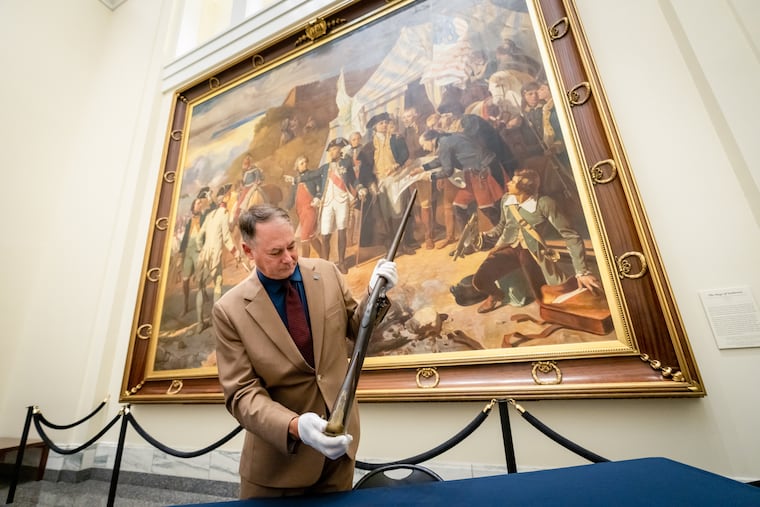A stolen musket from the Revolutionary War returns to Philly
The 18th-century firearm was stolen 56 years ago, but is now back at the Museum of the American Revolution.

An 18th-century musket that’s linked to the Revolutionary War was stolen in 1968 from Valley Forge Park, leading to years of investigation. When the cherry wood and brass-made firearm, once a part of the Valley Forge Historical Society Museum collection, went missing, it left many historians and investigators in limbo for decades.
But with help from Upper Merion Township detectives and the FBI’s Art Crime Team, the prized relic was returned to the Museum of the American Revolution on Monday.
The .78-caliber musket was displayed on a blue cloth-covered table, just under the dramatic painting, Siege of Yorktown in Virginia. Museum president and CEO Scott Stephenson held the antique in his hands, noting how the details etched in the gun’s 45-inch barrel and engraved butt plate noted its historic origins.
“There were no machines cranking these parts out,” Stephenson said. “This is literally hammer in hand, steel, iron, brass, and wood carefully pinning these pieces together.”
The retrieval of the 250-year-old firearm was a battle on its own. Until recent months, there was no trace of the musket for 56 years.
In 2009, Kevin Steele of the Montgomery County District Attorney’s Office reopened a cold case on the theft of antique firearms from the Valley Forge Historical Society Museum and several law enforcement agencies joined the effort to retrieve them. Among these firearms was the New England musket.
On the local level, Upper Merion Township Detectives Brendan Dougherty and Andrew Rathfon were tasked with retrieving the musket, as well as other Revolutionary War antiquities. Between 2016-2022, they were joined by the FBI Art Crime Team, the U.S. Attorney’s Office, and others on the investigation.
The collective effort resulted in the arrest of two people and the recovery of 50-60 historic items that were returned to 25 different museums along the East Coast. But dozens of artifacts were still missing, including the treasured musket.
In March, Massachusetts-based arms appraiser Joel Bohy spotted an early 1770s firearm during an antique gun show in Baltimore, which ended up being the one stolen from Valley Forge Park.
Bohy knew it was Rhode Island-made. The engraved butt plate signals its New England origins. But he didn’t know the significance of the artifact until he saw a press release from Upper Merion Township detectives.
“When I first saw the gun at the show, I was pretty excited about it because it’s a really rare gun,” Bohy said. “It was even more exciting when three weeks later, Upper Merion Township police sent me a press release with the missing things retrieved from the cases they worked on before. As as soon as I saw [the musket], I clicked on the images and went, ‘Oh my God, I saw this gun weeks ago.’”
Bohy reached out to Dougherty and Rathfon, who he had worked with on cases before. The next day, the FBI team interviewed Bohy, and the two parties were able to track down the musket and deliver it to the insurance solutions company, Chubb.
Chubb paid the insurance claim for the missing relic back in 1969, which meant that it was now its official owner. Since the Museum of the American Revolution acquired the collection of the Valley Forge Historical Society back in 2003, the organization decided to gift the musket to the museum.
“We’ve obviously devoted many years to this investigation and we’re still going. But it’s special because it was stolen from our home,” Dougherty said. “And to know after 56 years it’s home is nice because it’s such a local historic item.”
With the firearm now in the hands of Stephenson and the museum’s curators just days before July Fourth, Chubb executive Maria Thackston said it’s a “poetic” story of repatriation.
“We’re thrilled to give it back to them, allow them to continue to study it, and make it available for the public to enjoy it,” she said. “It’s our privilege.”
While there are no current plans to exhibit the rare firearm, the museum will continue to study the artifact until plans for display unfold at a later date.
Staff writer Raymond Ragland contributed to this article.